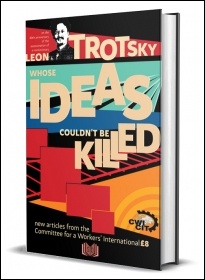Book Review: A revolutionary whose ideas couldn’t be killed
Trotsky’s ideas live on in the CWI
Mark Best, Socialist Party national committee
Eighty years after his assassination, the Committee for a Workers’ International (CWI) has published a collection of ten essays on the life and ideas of Leon Trotsky. It’s a portrait of a lifelong revolutionary, one of the leaders of the Russian Revolution alongside Lenin, who was persecuted, exiled and murdered at the say-so of Stalin. Trotsky was killed because of his struggle for the genuine ideas of Marxism, against the distortions of the Stalinist bureaucracy.
Peter Taaffe, describing the Transitional Programme, writes: “Here unfolds before us in all its richness the application of the method of Marxism to the historical tasks of the workers’ movement”. These essays are in the same vein. Trotsky engaged with debates and revolutionary struggles, and leaves a wealth of material to be studied and used in the fight for socialism today.
“We cannot select the arena and the conditions for our activity to suit our own likes and dislikes”, Trotsky wrote, regarding the trade unions in Britain. This book provides clarity to many contradictory and complex conditions we face today and combines the lessons of Trotsky’s works with an analysis of the present time.
Political programme
What programme is necessary to bridge the gulf between the necessity of the socialist transformation of society and the confidence of the working class to lead that transformation? What lessons can be learnt from the fight against German fascism? How should socialists work in trade unions whose leaders will line up with the bosses rather than struggle for socialism? How do socialists relate to movements for national independence?
These questions can only be answered by an analysis of the concrete situation – the mood and movements of class forces, tactical flexibility, and an unwavering confidence in the ability of the working class to run society for itself.
Trotsky in the 1920s and 30s was writing at a time of capitalist crisis and decay. His writings deal with the tempo of events, of revolutions and counter-revolutions, of mass movements, war, and missed opportunities for socialist change.
His analysis of the Soviet Union was that it degenerated into a bloody mockery of socialism, but which still gave a glimpse of something different to capitalism. Without understanding the class nature of the Soviet regime, it would have been impossible to understand the effects that capitalist triumphalism had on mass consciousness after its collapse, or to build support for socialism in Russia and Eastern Europe today.
It was experience of the class struggle, and through debates and discussions in the workers’ movement, that Trotsky, Lenin and others developed their ideas and understanding of the importance of the need for a party to fight for these ideas.
Trotsky spent the last years of his life building a new socialist international organisation – the Fourth International from supporters of the International Left Opposition in the Communist International, and workers moving into struggle. This was after reaching the conclusion that a new organisation was needed after the transformation of the Third International into the “border guard” of the Stalinist Soviet Union. He wrote in 1935 that this was “the most important work of my life” – fighting to maintain the thread of the ideas and methods of Marx, Engels and Lenin.
“Political leadership in the crucial moments of historical terms can become just as decisive a factor as is the role of the chief command during the critical moments of war. History is not an automatic process.” Trotsky fought for a revolutionary party, armed with a programme to unite the working class in common struggle against the capitalist system.
The CWI stands in this tradition of genuine Marxism against the attempts to bury it by Stalinism, groups that reduce it to a dry dogma with one-sided phrases without grasping the method, and those that abandon a systematic orientation to the working class; impatiently looking for other forces capable of transforming society.
Trotsky a revolutionary whose ideas couldn’t be killed
Leon Trotsky – A Revolutionary Whose Ideas Couldn’t Be Killed book cover (Click to enlarge: opens in new window)
- This is a must read book for workers and youth who want to find out about Trotskyism, and the relevance of Marxist ideas today – revolutionary ideas that are invaluable in the struggle to build the socialist forces necessary to end the misery and chaos of capitalism. Don’t delay – order your copy today.
- The discount price of £6 is extended until 22 November.
- Order now at leftbooks.co.uk










